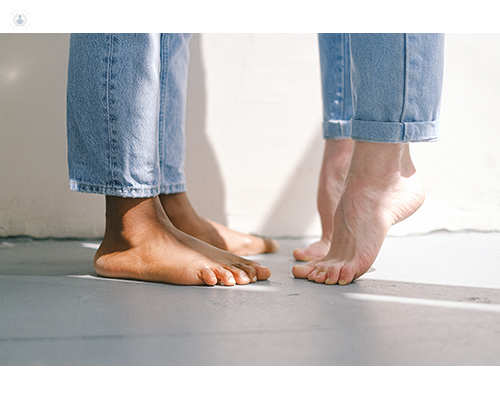Flat feet: do I need surgery?
Autore:Flat feet occurs when one or both of your feet have little (or no) arches, causing your feet to press flat on the ground when you stand. This is a common and usually painless condition, but it can become a cause of foot, ankle and knee issues if it becomes symptomatic.
In this article, leading consultant orthopaedic surgeon, Mr Vail Karuppiah discusses what are the symptoms of flat feet, what are the types of treatments available, and when surgery is necessary to correct flat feet.

What symptoms are associated with flat feet in adults?
The symptoms of flat feet are quite varied. You can start with anything as simple as general pain, usually starting in the inside of the ankle, associated with long-term standing or physical activities. This can be associated some times with some degree of swelling. The initial symptoms are only intermittent, which means they’re there for some days and then go away depending on what activities you engage in. As time progresses, the symptoms can become more severe and persistent. Your pain starts becoming global, which means that the inside ankle and the outside of the ankle also hurt, and the pain is, again, more consistent. You feel pain almost every day.
Is it serious? Is treatment always necessary?
It's not a serious condition. Treatment depends on the degree of your symptoms.
If your symptoms are intermittent, you usually get away with it and don't need any major treatment for it. In the initial phase, you might need physiotherapy and improvement with insoles or even shoe modifications.
The treatment becomes necessary when the pain is consistent, a stage at which the treatment can vary. The initial phase, again, involves trying to treat flat feet with supportive shoes - insoles - which are built inside your shoe to keep the arch up and support your flat feet as much as possible. As time goes by, then surgical treatments are available.
What types of treatments are available?
I would divide the treatment in two phases – non operative and operative phases.
The first one is when the symptoms are mild or moderate, and come in intermittent phases. At this stage, you do a non-operative treatment, which aims to keep the feet in a good position where they’re not flat. As a result, you have supportive arches, which are in the form of insoles. The best insoles are custom-made for your feet, as one size doesn't fit all. There are also commercial insoles which you can get online, but they usually don't work as good as insoles that are specifically made for your feet.
Physio helps to certain extent - that's the second part of your treatment - and has the objective of strengthening the tendons. In the initial phase, they do give some modest degree of benefit.
Modification of lifestyle is the third thing you need to target at. This means that if you're on a job which consistently makes you stand for long periods of time, you probably need to modify your job which is more administrative or has lesser standing periods. If you're always on your feet, doing lots of exercise, then you should modify the type of exercise, perhaps by doing lower-impact exercises.
When it comes to a stage where none of these treatments work, then you are looking towards an operative phase.
The operative phase, again, is varied, because symptoms of flat feet range from one spectrum end to the other. What we do operatively, depends on how much we are going to treat and what we need to treat. For example, if you have a deformity – that is your flat feet is permanently fixed – then the treatment will be different to a deformity which can be corrected by insoles.
So, in a nutshell, surgical measures are there, but what we do in treatment varies from what we find in the clinical examination.
When is surgery necessary to correct flat feet?
Flat feet condition is only treated if you're symptomatic. A lot of people are born with flat feet, but they're not exactly symptomatic from it. This is actually a common misconception, especially when you go to a podiatrist or a specialist who make insoles and you think that you are stuck with insoles because you have flat feet. I think that's the wrong way of treating it. People have to remember that a small proportion of the population will have flat feet, but not everyone will be symptomatic from it.
Surgery is only necessary if you're symptomatic and if you find that all of the other measures to treat your flat feet are not working.
How does corrective surgery work?
The aim of any corrective surgery for flat feet is to get the feet back in the correct shape. Flat feet is basically a fallen foot arch, meaning that your feet are flat on the ground, like a pancake. The second feature of flat feet is that all of your feet are pointing outwards, causing compression on the tendons, which are running on the side of your foot.
The surgery’s goal is to get the shape back, where you're trying to recreate an arch by different means. This could be as simple as doing a soft tissue correction, which would involve transfer of tendons and reposition things, or it could be breaking, resetting, and even fusing smaller joints to get the shape back. This varies depending on the individual patient, depending on how extended the flat feet is, so it’s hard to put it in one line, but we do various things to treat flat feet, keeping in mind that we want to get the shape back and reduce the pain.
Is it a risky procedure?
Any surgery has its own risk, this surgery is not any less.
Flat feet has certain things that can be done simple, which means that the surgical risk is far lower. However, some cases of flat feet need a bigger amount of surgery, and then, the risk is higher. Rather than thinking about the risk of surgery, you should think about the recovery time. I think that's more important.
Any flat feet surgery has a recovery time of two to three months. Patients have to be ready to engage themselves for the two or three months, and this only involves getting back to their regular activities. Fully recovering from flat feet can take almost a year, and this is recovery from the swelling and the discomfort from surgery. So, there is a huge engagement from the patient in terms of surgical outcome. Patients have to remember that it's not a simple, quick fix. It does take a while to recover from it. The risk is there, but it's not different from other surgeries that you would engage yourself in.
Mr Vail Karuppiah is a highly esteemed consultant orthopaedic surgeon in Nottingham, who specialises in foot and ankle surgery, including minimally-invasive bunion surgery, first MTP joint replacement and adult-acquired flat feet. If you have flat feet and wish to book a consultation to know more about this condition, don’t hesitate to visit Mr Karuppiah’s Top Doctors profile today.


